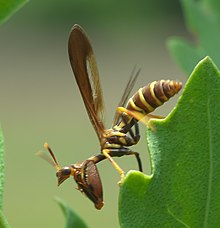
The insect order Neuroptera, or net-winged insects, includes the lacewings, mantidflies, antlions, and their relatives. The order consists of some 6,000 species. Neuroptera is grouped together with the Megaloptera and Raphidioptera (snakeflies) in the unranked taxon Neuropterida.

Mantispidae, known commonly as mantidflies, mantispids, mantid lacewings, mantisflies or mantis-flies, is a family of small to moderate-sized insects in the order Neuroptera. There are many genera with around 400 species worldwide, especially in the tropics and subtropics. Only five species of Mantispa occur in Europe. As their names suggest, members of the group possess raptorial forelimbs similar to those of the praying mantis, a case of convergent evolution.
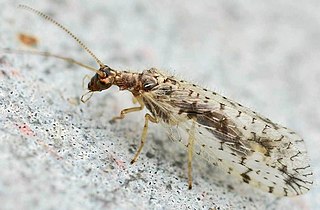
Hemerobiidae is a family of Neuropteran insects commonly known as brown lacewings, comprising about 500 species in 28 genera. Most are yellow to dark brown, but some species are green. They are small; most have forewings 4–10 mm long. These insects differ from the somewhat similar Chrysopidae not only by the usual coloring but also by the wing venation: hemerobiids differ from chrysopids in having numerous long veins and forked costal cross veins. Some genera are widespread, but most are restricted to a single biogeographical realm. Some species have reduced wings to the degree that they are flightless. Imagines (adults) of subfamily Drepanepteryginae mimic dead leaves. Hemerobiid larvae are usually less hairy than chrysopid larvae.

Rhachiberothidae, sometimes called thorny lacewings, are a family of winged insects in the order Neuroptera. The family has only 14 extant species in 4 genera found in Sub-Saharan Africa, but has a diverse fossil record extending back to the Early Cretaceous in Lebanon, Eurasia and North America. Like the closely related Mantispidae members of the group possess raptorial forelegs, which probably only evolved once in the common ancestor of the groups.
Sam W. Heads is a British palaeontologist, a Fellow of the Linnean Society of London, a Fellow of the Royal Entomological Society, as well as a former Officer and Editor-in-Chief at the Orthopterists' Society.
Dicromantispa electromexicana is an extinct species of mantidfly in the neuropteran family Mantispidae known from a fossil found in North America.
Feroseta is an extinct genus of mantidfly in the neuropteran family Mantispidae known from a fossil found in North America, and which contains a single species, Feroseta prisca.
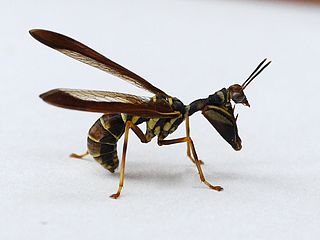
Climaciella brunnea, known sometimes by the common names wasp mantidfly, western mantidfly, and brown mantidfly, is a predatory neuropteran insect in the family Mantispidae.

Leptomantispa pulchella is a species of mantidfly in the family Mantispidae. It is found in the Caribbean Sea, Central America, and North America.

Leptomantispa is a genus of mantidflies in the family Mantispidae. There are about seven described species in Leptomantispa.
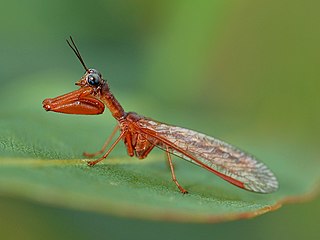
Mantispinae is a subfamily of mantidflies in the family Mantispidae. There are at least 30 genera and 310 described species in Mantispinae.

Zeugomantispa minuta, the green mantisfly, is a species of mantidfly in the family Mantispidae. It is found in the Caribbean Sea, Central America, North America, and South America.

Zeugomantispa is a genus of mantidflies in the family Mantispidae. There are at least three described species in Zeugomantispa.
Xeromantispa is a genus of mantidflies in the family Mantispidae. There is one described species in Xeromantispa, X. scabrosa.
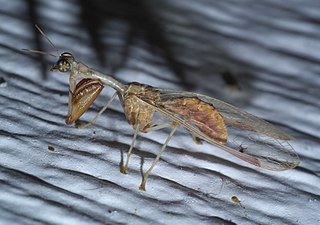
Dicromantispa interrupta is a species of mantidfly in the family Mantispidae. It is found in Central America and North America. Larvae develop in the egg sacs of hunting spiders. Adults have spotted wings.

Dicromantispa is a genus of mantidflies in the family Mantispidae. There are about 10 described species in Dicromantispa.

Dicromantispa sayi is a species of mantidfly in the family Mantispidae. It is found in the Caribbean Sea, Central America, and North America.
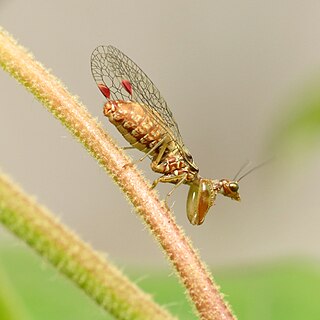
Nolima dine is a species of mantidfly in the family Mantispidae.

Nolima is a genus of mantidflies in the family Mantispidae. There are about seven described species in Nolima.
Sinuijumantispa is an extinct genus of mantidflies from the Early Cretaceous Sinuiju Formation in North Korea.
